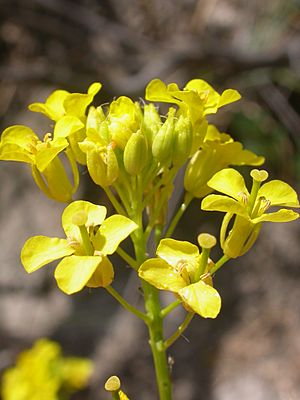Sisymbrium loeselii facts for kids
Quick facts for kids Sisymbrium loeselii |
|
|---|---|
 |
|
| Scientific classification | |
| Genus: |
Sisymbrium
|
| Species: |
loeselii
|
Sisymbrium loeselii is a type of flowering plant in the Brassicaceae family, also known as the mustard family. It has several common names, including small tumbleweed mustard, false London-rocket, and tall hedge mustard. This plant originally comes from Europe and Asia. However, it has spread to other parts of the world, where it is often seen as an introduced species or a common weed growing along roadsides.
Contents
What is Small Tumbleweed Mustard?
Small tumbleweed mustard is an annual herb, which means it completes its entire life cycle in one year. It grows from a seed, flowers, produces new seeds, and then dies, all within a single growing season. This plant is known for its ability to spread easily and grow in many different places.
How Does It Look?
This plant usually has a hairy stem that grows straight up. It can become quite tall, sometimes reaching over a meter (more than 3 feet) in height!
- Leaves: The leaves are divided into different shapes, like triangles or long, narrow sections. They also have jagged edges, like teeth. These leaves grow on small stalks called petioles.
- Flowers: At the top of the stem, you'll find a cluster of bright yellow flowers. Each flower has petals that are just under a centimeter long. This cluster of flowers is called a raceme.
- Fruit: After the flowers bloom, the plant produces long, thin seed pods called siliques. These pods can be up to 3.5 centimeters (about 1.4 inches) long and contain many tiny seeds.
Where Does It Grow?
While small tumbleweed mustard is native to Eurasia (Europe and Asia), it has traveled to many other continents. It often grows in disturbed areas like fields, gardens, and especially along roadsides. Because it spreads easily, it can sometimes become a common plant in new areas.
Special Abilities of the Plant
Small tumbleweed mustard has a cool trick called allelopathy. This means it can produce special chemicals that affect other plants growing nearby.
How It Stops Other Plants
The chemicals released by Sisymbrium loeselii can stop the seeds of other plant species from sprouting. For example, it can prevent seeds of grasses like bluebunch wheatgrass and Idaho fescue from growing.
It also affects tiny helpers in the soil. The plant can stop certain types of arbuscular mycorrhizal fungi, like Glomus intraradices, from growing well. These fungi usually help plants take in nutrients from the soil, so by stopping them, the mustard plant can get more resources for itself.
Uses of the Plant
Even though it's often considered a weed, the leaves of Sisymbrium loeselii can be used in food! They have a spicy flavor, strong enough to be compared to wasabi. You can also mix them into salads or other dishes to add a unique taste.

